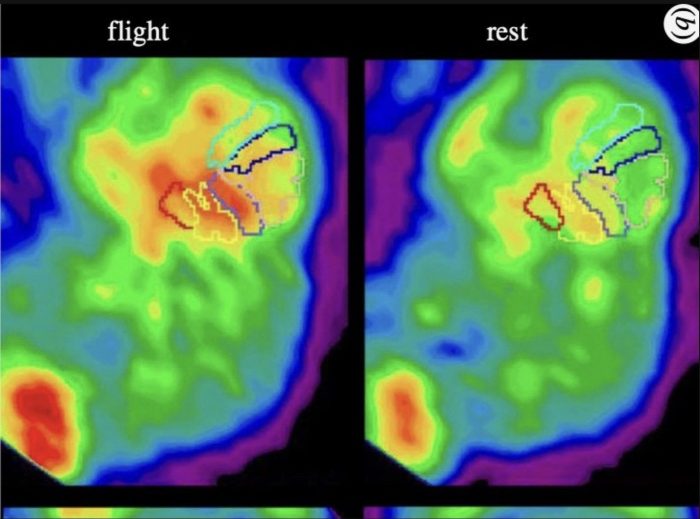SBU News: How did bird-like dinosaurs evolve the ability to fly?

Study Involving Advanced Brain Imaging Reveals Expansion of the Cerebellum was Key
An international team of researchers led by Amy Balanoff, PhD, at Johns Hopkins Medical Institute and Paul Vaska, PhD, at Stony Brook University combined the use of positron emission topography, or PET scans, of modern pigeon brains and studies of dinosaur fossils to help answer an ongoing question in evolutionary biology: How did the brains of birds evolve to enable them to fly? The answer, detailed in a paper published in the Proceedings of the Royal Society B., appears to be an adaptive increase in the size of the cerebellum in some fossil vertebrates.
The evolution of flight is a rare event in vertebrae history, and one that demands functional integration across multiple anatomical/physiological systems. This new research combined modern PET scan imaging data of ordinary pigeons with the fossil record, examining brain regions of birds during flight and braincases of ancient dinosaurs.
The PET imaging and analysis for the study was conducted at Stony Brook University by a team of graduate and undergraduate students led by Vaska, a senior author on the paper, and Professor in the Departments of Radiology and Biomedical Engineering in the Renaissance School of Medicine at Stony Brook University. Lemise Saleh, a graduate student in the PhD program in BME at Stony Brook, was one of the three lead authors.
The researchers performed PET imaging scans to compare activity in 26 regions of the brain when the bird was at rest and immediately after it flew for 10 minutes from one perch to another. PET scans show the location and amount a tracer compound similar to glucose, indicating increased use of energy and thus brain activity (the tracer rapidly degrades and is excreted from the body).
Vaska collaborated closely with Amy Balanoff, lead author of the study, along with the rest of the research team, in order to compare the brain activity of modern pigeons before and after flight.
Of the 26 regions, one area — the cerebellum — had statistically significant increases in activity levels between resting and flying. Overall, the level of activity increases in the cerebellum differed by more than two standard statistical deviations, compared with other areas of the brain. This makes sense because the cerebellum is a brain region responsible for movement and motor control.
The researchers also detected increased brain activity in the so-called optic flow pathways, a network of brain cells that connect the retina in the eye to the cerebellum. These pathways process movement across the visual field.
Their novel research links the cerebellum findings of flight-enabled brains in modern birds to the fossil record, which showed how the brains of bird-like dinosaurs began to develop brain conditions for powered flight. The team’s overall data is an important step toward establishing how the brain of modern birds supports their unique behaviors and provides insights into the neurobiology of the bird-like dinosaurs that first achieved powered flight.
“PET imaging is really the only way to directly assess brain function across the whole brain during animal behavior,” says Vaska. “Because of our expertise and resources in PET technology, we were able to design a study that used PET to effectively capture the brain activity during flight, and then discovered the primary role of the cerebellum. This lays the groundwork for future studies to better understand brain evolution across species.”
Connecting the findings to avian dinosaurs
The researchers used a digitized database of endocasts, or molds of the internal space of dinosaur skulls, which when filled, resemble the brain’s outer shape. They identified and traced a sizable increase in cerebellum volume to some of the earliest species of maniraptoran dinosaurs, which preceded the first appearances of powered flight among ancient bird relatives, including the well-known Archaeopteryx, a winged dinosaur.
They also found evidence in the endocasts of an increase in tissue folding in the cerebellum of early maniraptorans, an indication of increasing brain complexity. They noted that their tests involved straightforward flying, without obstacles and with an easy flightpath, and that other brain regions may also be active during more complex flight maneuvers.
Their next step in the ongoing research is to pinpoint precise areas in the cerebellum that enable a flight-ready brain and the neural connections between these structures.
The research was supported in part by the National Science Foundation.






